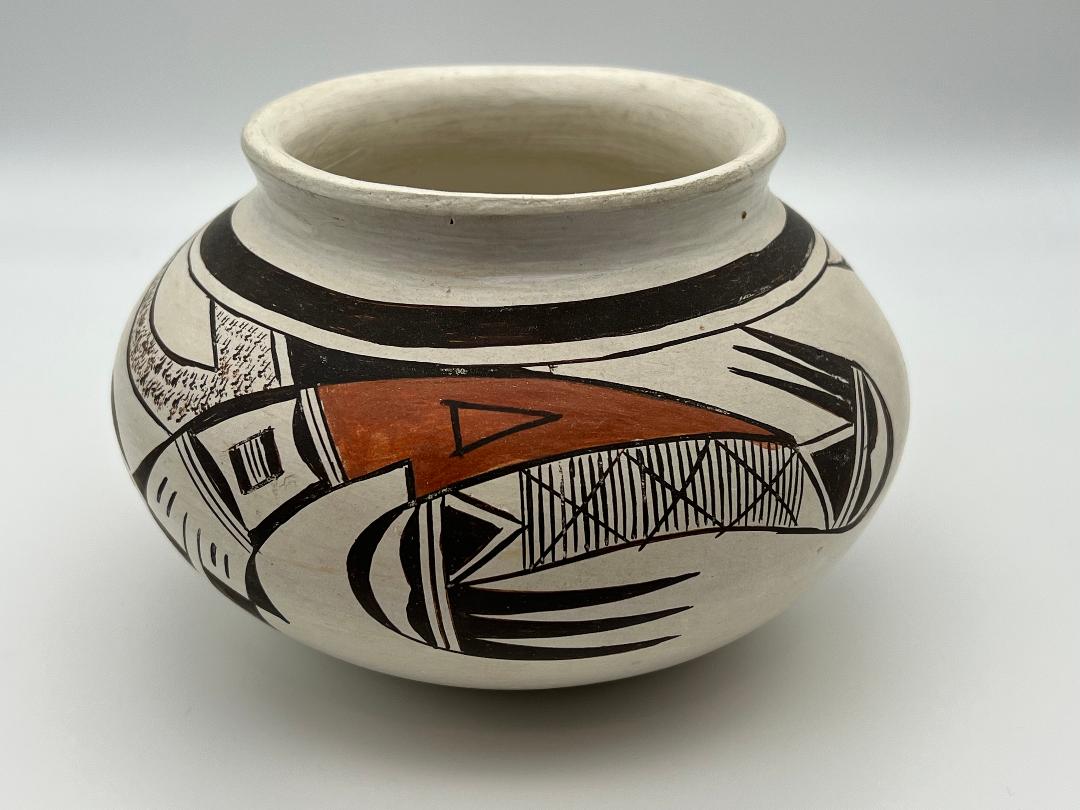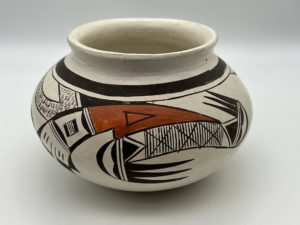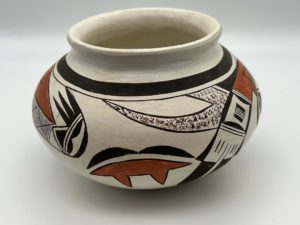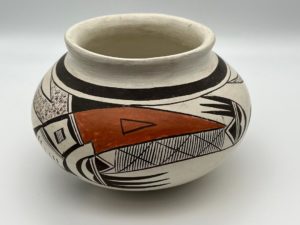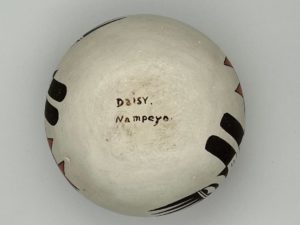At first view this is a well-done but rather ordinary Hopi-Tewa pot. What is unusual is that this Hopi pot is made with Zuni clay at Zuni by a master Hopi potter. That simple statement summarizes the complicated life of its maker, Daisy Hooee Nampeyo.
While this collection has seven Hopi pots by Daisy, jar 2020-05 is only the second Zuni-clay pot by Daisy in the collection. (See 2007-02 for the other.)
Form:
Sometimes white kaolin slip is used on Hopi pottery (Appendix A), but pot 2020-05 is formed of this clay and is not slipped. The outer surface and the inside of the neck are stone-polished. The jar is distinctly bulbous, a form that distinguished Daisy’s work (cf 2019-16). The jar has a short neck with outward flaring.
Design:
The design has thick-over-thin framing lines just below the neck of the jar. The bottom edge of the design is unbounded.
The pot carries two designs, each repeated twice.
Design #1:
The larger design is organized around a typical Hopi abstract bird form. While the elements of design are the same in both renditions, one version is about 37% longer and 20% wider than its companion. I assume the larger version was painted first and the smaller in the residual space.
The head of the bird is red and has the form of a curved triangle with a small section cut away at its rear, rather like a large knife blade with a short chunky handle. Floating in this form is a isosceles triangle defined by a black border, an abstract representation of an eye.
The design section behind this head is bounded by unpainted strips containing three parallel lines, “two-lane highways” that were favored by Nampeyo to segregate sections of her designs. The top and bottom edges of this area are painted with thick black lines; on the right and left walls these lines thicken and form low hills. Equidistant from these walls, an square design floats in space, its right and left edges painted with additional thick black lines, at its center three thin lines.
At the rear of the bird is a mostly unpainted comb form that divides into two rectangular bases for the two feathers that form a tail. Each base contains a simple element of two parallel lines alined with the tails. Beyond the comb, the tails are solid black.
Clustered around this avian core are an assemblage of designs. External to the core body of the bird, between the red head and the black tail tips, is a thick black line that expands into black fins on either side of the white comb.
Above the red head of the bird a small solid black triangle fills the space between the head and the framing lines above, terminating in a one-lane “highway.” Behind it is a slpatted form that is both 1) a long curved fin that arches off the mid body of the bird, its point touching the thin framing line above and 2) a straight edged and pointed form whose upper edge is the thin framing line. These two elements have a common base.
Pendant to the red head of the central bird is a graceful and familiar form, a variation of the “fine-line migration” design that is a Nampeyo family hallmark (cf 1994-12 and 2017-10). Central to the design is a line of 45 parallel, vertical lines in three groups, each group of 15 lines criss-crossed by a large “X.”
At each end of cross-hatched section is a roughly square area intruded into by a solid black triangle pointing toward the center of the design. though in some cases one wall of the square has been pushed outward. This black form is edged by thin black lines forming a parallel, encasing triangle. The residual area of the rectangle is therefore also triangular but facing toward the ends of the design.
However the details of how these nesting triangles are formatted differ and seem 1) to have two different layouts, modified further by 2) variations in painting. The right end of the design has the simplest form with the black-bordered triangle occupying the upper portion of the square area and the lower white triangular area simply residual to it .
The square at the left end of the design has the black triangle more centered in the space, with smaller unpainted triangles flanking it. These flanking unpainted triangles are of irregular size depending on how the central black triangle was placed, one rendition being more symmetrical than the other.
A wing form completes the design, with the curved hump of the wing based on a two-lane highway, surmounted by two solid black hills, with a thick black parentheses arching over these elements. Finally three long triangular feathers arc back towards the center of the design. The top wing fills the limited space between the red head of the central bird and the framing lines, and is thus smaller than the lower wing which extends into the unpainted space below the design.
None of the elements in this complex avian design is particularly unique to the Nampeyo family repertoire, but their grouping seems unique to this jar.
Design #2:
Between these major design areas is a smaller and simpler design with two elements. The solid red element has a curved upper border and a straight lower border, like a bow. The linearity of the straight edge, however, is broken by two pendant isosceles triangles, the overall effect being somewhat like a turtle standing on pointed feet. Zuni is known for its carved fetishes and this red form might better be described as an abstract animal shape.
Above are two curved black elements like bean pods touching.
Daisy’s history:
The story of Daisy’s life is told in more detail in the catalog entry for pot 2011-13. Briefly, as a teenager she developed cataracts in her eyes and began to go blind. She moved to Los Angeles with a wealthy White family who arranged for successful surgery, then Daisy continued to travel with that family around the world, including training at L’Ecole de Beaux Arts, in Paris. She eventually returned to Hopi and married, divorced, and then moved to Zuni to marry and eventually remarried after her second husband died. While Zuni remained her home and she continued to make Hopi pots using Hopi clay, she also began making Zuni-style pots using Zuni clay, part of an effort to revive Zuni pottery making.. In 1960 she established a traditional Zuni pot making class at Zuni High School. Later she made a unique pot that displays Zuni frogs on a Hopi pot (2011-13). Like that pot, the mixed artistic heritage of pot 2020-05 is a measure of the unusual personal journey of its maker.
As a Hopi-appearing pot made at Zuni of Zuni clay, it shares pedigree with two pots by Bobby Silas recently added to the collection, 2020-07 and 2020-08.

